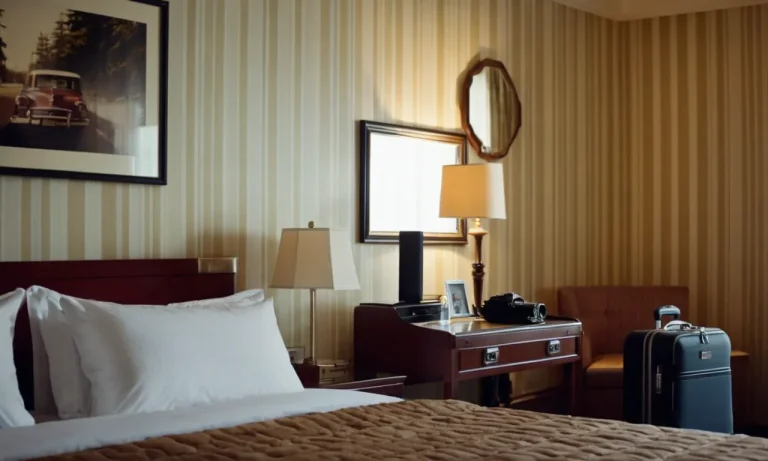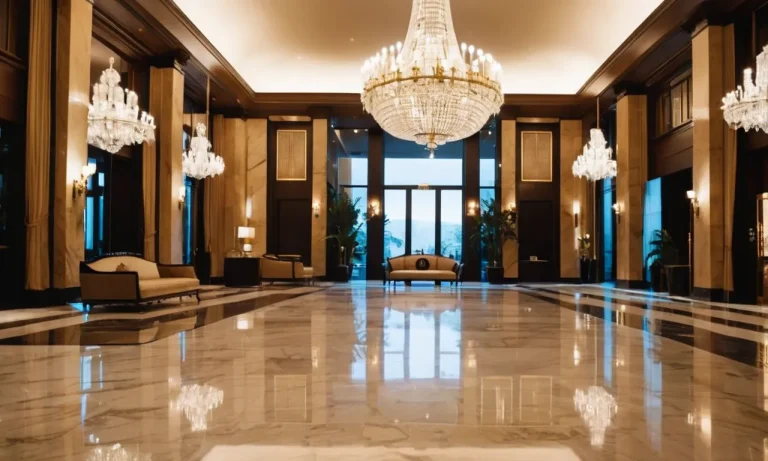What Is The Oldest Hotel In America?
Imagine stepping into a place where history whispers from every corner, where the walls have witnessed the passage of time and the footsteps of countless travelers. Welcome to the world of America’s oldest hotels, where the past and present intertwine in a captivating tapestry of hospitality.
If you’re short on time, here’s a quick answer to your question: The Oldest Hotel in America is The Beekman Arms and Delamater Inn, located in Rhinebeck, New York. This historic establishment has been welcoming guests since 1766, making it a true gem in the annals of American hospitality.
In this comprehensive article, we’ll delve into the rich history and fascinating tales that surround America’s oldest hotels. From their humble beginnings to their enduring legacy, we’ll uncover the secrets that have kept these iconic establishments standing tall through the centuries.
Get ready to embark on a journey through time, where every room holds a story waiting to be told.
The Beekman Arms and Delamater Inn: A Timeless Treasure
Origins and Early Years
Nestled in the heart of Rhinebeck, New York, the Beekman Arms and Delamater Inn stands as a testament to America’s rich history. Established in 1766, this iconic establishment proudly holds the title of the oldest continuously operating hotel in the United States.
Its origins can be traced back to the early days of the American Revolution, when it served as a gathering place for soldiers, travelers, and local residents alike.
According to the inn’s official website, the Beekman Arms was originally constructed as a modest house by William Traphagen, who later transformed it into a tavern. In 1804, the Delamater family acquired the property and expanded it, adding the adjoining inn, creating the unique compound we know today.
Over the years, the inn has undergone several renovations and expansions, while carefully preserving its historic charm and architectural integrity.
Architectural Marvels and Preservation Efforts
The Beekman Arms and Delamater Inn is a true architectural marvel, boasting a blend of Dutch and English Colonial styles. Its iconic façade, adorned with intricate woodwork and charming gables, transports visitors back in time.
The interior is equally captivating, with original fireplaces, wide-plank floors, and exposed beams that have weathered the test of time.
Recognizing the inn’s historical significance, it has been designated as a National Historic Landmark by the U.S. Department of the Interior. This prestigious recognition underscores the importance of preserving this iconic structure for future generations.
Thanks to the tireless efforts of dedicated preservationists and the local community, the inn has undergone meticulous restoration projects to maintain its authenticity while adapting to modern amenities and guest comforts.
Notable Guests and Historical Significance
Throughout its illustrious history, the Beekman Arms and Delamater Inn has welcomed a diverse array of notable guests, including presidents, authors, artists, and influential figures from various walks of life.
Among its most famous visitors were Theodore Roosevelt, who stayed at the inn during his campaign for the Vice Presidency in 1900, and Henry Wadsworth Longfellow, the renowned American poet who penned the famous lines “Listen, my children, and you shall hear of the midnight ride of Paul Revere” while residing at the inn in 1849.
Beyond its illustrious guests, the Beekman Arms and Delamater Inn holds a significant place in American history. During the Revolutionary War, it served as a gathering spot for patriots and soldiers, hosting meetings and discussions that shaped the nation’s future.
Today, the inn remains a cherished landmark, offering visitors a glimpse into America’s storied past while providing a unique and unforgettable hospitality experience. 😊
Other Contenders for America’s Oldest Hotel
While the Omni Parker House in Boston claims to be the oldest continuously operating hotel in America, several other historic establishments vie for the title. Here are a few notable contenders:
The Omni Parker House in Boston
Originally opened in 1855 as the Parker House Hotel, this iconic Boston landmark has been welcoming guests for over 165 years. It boasts a rich history, having hosted luminaries such as Charles Dickens, Ralph Waldo Emerson, and John F. Kennedy.
The hotel’s Parker’s Restaurant is credited with creating the beloved Boston cream pie, further cementing its place in culinary history. According to the Omni Hotels website, the Parker House underwent a multi-million dollar renovation in the 1990s, preserving its historic charm while offering modern amenities.
The Omni Homestead Resort in Hot Springs, Virginia
Established in 1766, The Omni Homestead Resort claims to be America’s first resort. Nestled in the Allegheny Mountains, this iconic getaway has hosted numerous U.S. presidents, including Thomas Jefferson and William Howard Taft.
With its natural hot springs and stunning scenery, the resort has been a popular destination for centuries. 😍 In 2020, it underwent a $25 million renovation, ensuring its historic charm remains intact while offering contemporary comforts to guests.
The Omni Royal Orleans in New Orleans
Dating back to 1843, The Omni Royal Orleans is a French Quarter gem that exudes the charm and elegance of the Big Easy. This iconic hotel has hosted many famous guests, including Mark Twain and Winston Churchill.
Its prime location on St. Louis Street puts guests in the heart of New Orleans’ vibrant culture and cuisine. 👏 According to the hotel’s website, the property underwent a $15 million renovation in 2018, blending modern amenities with its historic character.
While each of these hotels has a strong claim to being the oldest in America, their longevity and rich histories are a testament to the enduring allure of hospitality and travel. Whether you’re seeking a taste of history or simply a luxurious escape, these iconic establishments offer a unique glimpse into America’s storied past.
🎉
Preserving History: The Challenges and Triumphs
Maintaining Authenticity in a Modern World
Preserving the authenticity of an historic hotel is a delicate balancing act. On one hand, guests expect modern amenities and conveniences, such as high-speed Wi-Fi, updated bathrooms, and comfortable beds.
On the other hand, the charm and character of an old property lie in its ability to transport visitors back in time. Successful historic hotels find ways to blend the past and present seamlessly, retaining original architectural details and period furnishings while offering contemporary comforts.
One example of a hotel that has mastered this balance is the Omni Royal Orleans in New Orleans, which dates back to 1843. According to their website, the hotel has maintained its iconic wrought-iron balconies, courtyard fountains, and grand chandeliers, while also renovating guest rooms and public spaces to meet modern standards.
It’s a challenge, but one that’s essential for historic hotels to remain relevant and attract guests of all ages.
Adapting to Changing Guest Expectations
In addition to balancing authenticity and modernity, historic hotels must also adapt to evolving guest expectations. Today’s travelers seek unique, immersive experiences that connect them to a destination’s history and culture. They want to feel like they’re part of the story, not just spectators.
Successful historic hotels leverage their rich histories to create memorable experiences, from themed dining and cocktail events to historical tours and reenactments.
The Historic Hotels of America program, which represents over 300 historic hotels across the United States, reports that experiential travel is a growing trend, with 78% of affluent travelers seeking opportunities to immerse themselves in local culture and history.
Hotels like the Omni Homestead Resort in Virginia, which dates back to 1766, offer a range of immersive experiences, from falconry lessons to historical reenactments, to cater to this demand.
Sustainability and Environmental Considerations
As the world becomes more environmentally conscious, historic hotels face the challenge of balancing preservation with sustainability. Many older buildings were not designed with energy efficiency in mind, making it difficult to reduce their carbon footprint.
However, innovative solutions like renewable energy sources, water conservation measures, and eco-friendly renovations can help historic hotels minimize their environmental impact without compromising their historic integrity.
The Historic Hotels of America Green Program recognizes and supports member hotels that implement sustainable practices. For example, the Willard InterContinental in Washington, D.C., which opened in 1818, has implemented initiatives such as energy-efficient lighting, water conservation measures, and a comprehensive recycling program.
By embracing sustainability, historic hotels can not only reduce their environmental impact but also appeal to eco-conscious travelers.
The Allure of Historic Hotels: Why They Matter
Historic hotels are more than just places to stay; they are living museums that transport us back in time, offering a unique glimpse into the past. These architectural gems hold a special allure, captivating travelers with their rich stories and cultural significance.
Let’s explore why these timeless treasures matter and why they continue to enchant visitors from around the world.
Connecting with the Past
Stepping into a historic hotel is like opening a portal to a bygone era. The very walls whisper tales of the illustrious figures who once graced its halls, from presidents and dignitaries to celebrities and literary giants. Each room, each corridor, holds a piece of history waiting to be discovered.
By immersing ourselves in these time-honored establishments, we forge a profound connection with the past, gaining a deeper appreciation for the stories that have shaped our world.
Unique Experiences and Storytelling
Historic hotels are not merely places to rest your head; they offer unparalleled experiences that transcend the ordinary. From lavish grand ballrooms that have hosted countless galas and celebrations to cozy libraries where literary masterpieces were penned, these hotels are steeped in stories waiting to be told.
Each nook and cranny holds a secret, a whisper from the past that adds depth and richness to our stays. According to a study by Historic Hotels of America, over 90% of travelers cite the desire for unique experiences as a driving factor in choosing historic accommodations.
Cultural and Architectural Significance
Beyond their captivating histories, historic hotels are often architectural masterpieces that have withstood the test of time. These buildings serve as living museums, showcasing the craftsmanship, design, and artistic vision of their era.
From grand lobbies adorned with intricate mosaics and ornate chandeliers to meticulously preserved guestrooms that transport us to a bygone age, every detail is a testament to the cultural and artistic heritage of our past.
According to the National Park Service, historic preservation efforts have saved countless architectural gems, ensuring that these treasures remain standing for generations to come.
Historic hotels are more than just places to stay; they are living time capsules that remind us of our roots, our stories, and our shared human experiences. By embracing these timeless treasures, we not only honor our past but also enrich our present with the wisdom, beauty, and resilience of those who came before us.
So, the next time you plan a journey, consider immersing yourself in the allure of a historic hotel – it’s an experience that will leave an indelible mark on your soul. 😊
Conclusion
As we bid farewell to our journey through America’s oldest hotels, we are left with a profound appreciation for the enduring spirit of hospitality and the resilience of these historic establishments. From the Beekman Arms and Delamater Inn to the other contenders, each hotel stands as a testament to the rich tapestry of American history, woven with tales of triumph, perseverance, and unwavering dedication.
These iconic landmarks remind us that the past is not merely a collection of faded memories but a living, breathing entity that shapes our present and guides our future. By preserving and celebrating these treasures, we honor the stories of those who came before us and ensure that their legacies continue to inspire generations to come.








